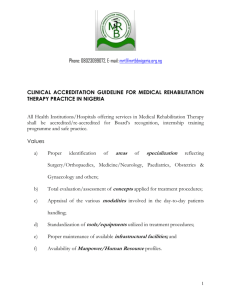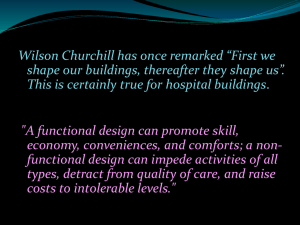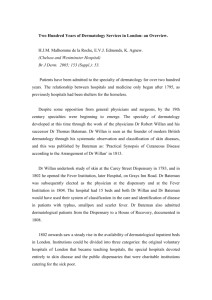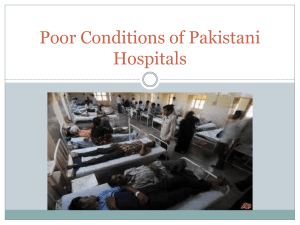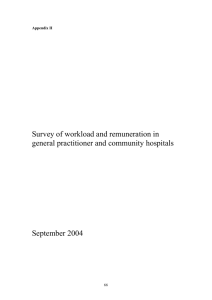Hospital reform Nigel Edwards
advertisement
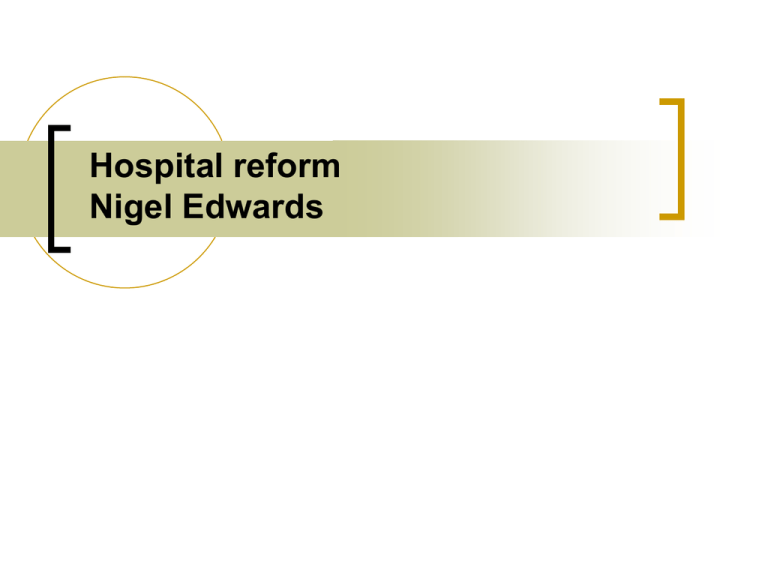
Hospital reform Nigel Edwards The same problems across Europe Growing demand Patients increasingly have..... Multiple chronic conditions Poly-pharmacy Dementia A need for care and support at home Ageing populations 16 15 14 13 12 11 10 9 8 1970 1975 1980 1985 1990 1995 2000 % of population aged 65+ years in Europe 2005 and...... Contracting finances & tax revenues The task is going to be how to do more with less This means some very different thinking International trends Focus on process efficiency Regionalisation of specialist work Fewer hospitals Reduced beds Pressures to centralise Links between quality and volume Other economies of scope & scale Perceived market advantages Workforce Shortages Working time restrictions Pressures to decentralise Migration of care out of hospitals Payer policy Out of hospital care assumed to be cheaper Preferred by users Technology Sustainability & environmental concerns Restructuring hospitals Throughout Europe, the number of hospital beds has been reduced in recent years and they are now used more intensively Increase in day surgery 700 600 500 400 Acute care hospital beds per 100,000 population in the EU 300 200 100 0 1980 1985 1990 1995 2000 2005 Source: WHO Europe, health for all database, January 2011 Average length of stay, acute care hospitals only, European Union average 12 10 8 6 4 2 0 1980 1982 1984 1986 1988 1990 1992 1994 1996 1998 2000 2002 2004 2006 2008 Acute (short-stay) hospitals per 100,000 Netherlands Israel United Kingdom Hungary Slovenia Ireland Croatia Spain Portugal Slovakia Belgium Czech Republic Austria Greece Italy Poland Germany Switzerland Lithuania Estonia Latvia France 0 0.5 1 1.5 2 2.5 3 3.5 Acute beds per 100,000 Acute care hospital beds per 100000, Last available Germany 2008 Austria 2008 Lithuania 2008 Slovakia 2008 CARK 2009 Romania 2008 Poland 2008 Luxembourg 2008 Latvia 2009 Belgium 2009 Greece 2008 Estonia 2008 Slovenia 2008 EU 2008 Iceland 1996 France 2008 Croatia 2008 Switzerland 2008 Italy 2008 Denmark 2008 Netherlands 2008 Portugal 2008 Malta 2009 United Kingdom 2008 Ireland 2007 Norway 2008 Spain 2008 Turkey 2008 Serbia 2009 Sweden 2005 Israel 2009 Finland 2008 0 500 1000 In-patient care admissions per 100, Last available Austria 2008 Romania 2009 Finland 2009 Germany 2008 Luxembourg 2007 Lithuania 2009 Hungary 2008 Czech Republic 2009 France 2009 Greece 2006 Poland 2008 Latvia 2009 Slovakia 2009 Norway 2009 Estonia 2009 Slovenia 2009 Israel 2009 EU 2009 Croatia 2009 Switzerland 2008 Belgium 2007 Sweden 2007 Ireland 2008 Denmark 2009 Italy 2008 United Kingdom 2009 Portugal 2008 Spain 2008 Netherlands 2008 0 10 20 30 International trends Quality Safety Healthcare infections and antibiotic resistance International trends Changes in governance Thinking about the hospital in new ways Changing governance and management Context Frequent reforms Groups of GPs will take over purchasing function More use of patient choice, competition & market mechanisms DRG & tariff payment The state to become less responsible for day to day management of healthcare Hospital governance Make hospital management more professional Reduce political interference Introduce business discipline Become more like other parts of the economy Hospital governance Link clinical decisions to financial decisions Strong involvement of doctors in management Reflects a general trend to decentralised decisions and a reduced role for central government English reform Create independent Foundation Hospitals Governed by a Board Appointed by governors elected by members: 5 Non executive Directors and a Chairman 5 Executives Staff Patients Public Note: No ministry or government representative Freedoms Surpluses retained Strategy Investment Pay and conditions Management arrangements Verdict Less change in performance than was hoped Less use of freedoms than expected Dealing with failure is still a problem Change of this type takes time Governments try and find new ways to impose control Now some interest in Concesión Administrativa Challenging the idea of hospitals Is the concept still valid? Hospitals are collections of different functions There were good reasons for putting these together but do these still apply? Rethinking hospitals 1 Many hospitals are a collection of things that no longer fit together Too specialised for much of their current general work Not specialist enough for the specialist work Not sufficiently integrated with other services – primary & social care The model only seems to work when its growing Different types of activity Relatively predictable, self-contained standardised, protocol driven ‘factory’ model Complex, uncertain, messy and with multiple external relationships: Elective surgery Imaging Laboratories Emergency medicine Primary care activity In the emergency department and outpatients Rethinking hospitals 2 Should there be more separation of different types of process, patient condition etc? Rather than separation based on the specialism of the doctors? This might mean...... ‘Focussed factories’ for high throughput elective surgery Multidisciplinary teams for messy & complex problems Hospitals need to be much more integrated with primary care in the management of chronic disease Close links to social care to allow rapid discharge & admission avoidance This might mean..... Hospitals not used for: Rehabilitation End of Life Other treatments possible at home Hospital for a chronic condition should be seen as indicating a failure of the system Rethinking hospitals 2 Change the physical structure of the hospital Fundamental changes in its relationship with patients, primary care and care outside hospitals Change the way its staff work This requires New incentives for hospitals New skills for primary care Redesigning the work of specialists in chronic diseases New mindsets Changing the rules • • Systems produce the results they are designed to get – so change the design rules to change the results Old Rules New Rules Redesign patient experience Treat each episode as a single (surprising) event Anticipate need and manage years of care Integrated approach with primary care We treat patients Patient self care Remote and home care Treat patients as though their time is free Eliminate wasted time and travel Redesign patient experience Move patients Move staff and information Batch and queue Patients flow through the system Patients (cont.) Give your details & history many times Provide information once Patients come to the ‘wrong place’ Systems are designed to be able to route the patient or provide the appropriate responses Front line Improve leadership & middle management Front of house Focus on operations and improvement Create space to think Train staff to solve root causes of problems Redesign how staff work Silos based on clinical disciplines Teams and functions based on patient need and processes Escalate up from junior to senior See someone senior and delegate See a doctor See the most appropriate professional Reduce the skills on wards Make sure the right skills are present …..how staff work 9-5 working Longer days Most things stop at the weekend Senior staff and diagnostics available Specialists manage patients Specialists provide advice to generalists Specialists work in the one hospital Specialists work in networks Rethink the system Beds are a symbol of prestige and a way of generating income Beds are a cost and a liability Care is fragmented between providers Integrated care Chaos and improvisation Systematic and organised Pathway based Variation tracked and feedback to staff Conclusions Some very challenging times a head Better integration and co-ordination will be vital Getting much more professional in how systems are run will be very important

